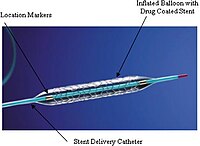
“To close or not to close?” When should vascular closure devices be used after cardiac catheterization procedures?
Sign Up to like & getrecommendations! Published in 2017 at "Catheterization and Cardiovascular Interventions"
DOI: 10.1002/ccd.27360
Abstract: Vascular closure devices (VCD) appear to be safe when compared to manual compression or surgical closure. VCDs’ main advantage seems to stem from lower time to hemostasis (TTH) and time to mobilization. In anticoagulated patients… read more here.
Keywords: closure; vascular closure; close close; catheterization ... See more keywords

Mynx Vascular Closure Device in Arterial Endovascular Procedures.
Sign Up to like & getrecommendations! Published in 2018 at "Annals of vascular surgery"
DOI: 10.1016/j.avsg.2017.05.009
Abstract: BACKGROUND Vascular closure devices have been used to achieve hemostasis of percutaneous access sites following endovascular procedures, with reported decreased time for arterial control as well as decreased time to ambulation. We sought to determine… read more here.
Keywords: closure; vascular closure; endovascular procedures; arterial endovascular ... See more keywords

Large arteriotomies closure using a combination of vascular closure devices during TEVAR/EVAR: A single centre experience
Sign Up to like & getrecommendations! Published in 2020 at "Indian Heart Journal"
DOI: 10.1016/j.ihj.2020.06.008
Abstract: In this case series, we share our experience of total percutaneous closure of large arteriotomies using combination of vascular closure devices (VCD). A total of six patients with seven sites for endovascular repair were taken… read more here.
Keywords: closure; vascular closure; combination vascular; closure devices ... See more keywords

TCT-194 Vascular closure devices are associated with lower risk of access site complications in high risk patients: the utility of risk calculator
Sign Up to like & getrecommendations! Published in 2017 at "Journal of the American College of Cardiology"
DOI: 10.1016/j.jacc.2017.09.266
Abstract: Access site complications (ASC) after peripheral vascular interventions (PVI) are associated with prolonged hospitalization and increased mortality. The association between the use of vascular closure devices (VCDs) and ASC as a function of a patient’s… read more here.
Keywords: risk; site complications; vascular closure; closure devices ... See more keywords

Vascular closure devices in living donor nephrectomy: a much-needed systematic review and meta-analysis focusing on safety.
Sign Up to like & getrecommendations! Published in 2023 at "BJU international"
DOI: 10.1111/bju.16025
Abstract: INTRODUCTION Staplers and nontransfixion techniques (polymer locking and metal clips) are the methods employed to secure the renal vessels during laparoscopic and robotic living donor nephrectomy (LDN), but the use of clips has come into… read more here.
Keywords: closure devices; safety; vascular closure; meta ... See more keywords

Use of Suture-Mediated Closure Devices for Closure of Punctures in Prosthetic Patches or Grafts is Associated With High Rates of Technical Success and Low Complication Rates
Sign Up to like & getrecommendations! Published in 2022 at "Vascular and Endovascular Surgery"
DOI: 10.1177/15385744211068626
Abstract: Objectives Despite the increasing use of endovascular techniques in the management of peripheral vascular disease, there is little data on the safety of percutaneous closure devices in punctures of synthetic vascular material. Our paper sought… read more here.
Keywords: closure devices; punctures prosthetic; success; closure ... See more keywords